How to Store Dehydrated Food
How to store dehydrated food is just as important to long-lasting quality as the care and attention you take in making it.
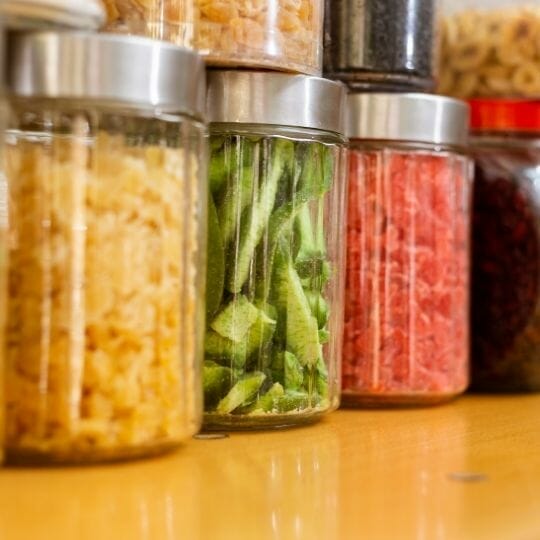
Also Read: Top Twelve Tips for Dehydrating Food, Recommended Temperatures for Dehydrating, Favourite Dehydrating Recipes
Biggest Threats to Dried Food
Before learning how to store dehydrated food, you need to understand the biggest threats to the quality and long term shelf life of dried food. When you know these, you’ll be better able to apply the tips for how to store dried foods in your house whatever climate you live in.
The biggest threats to quality and shelf life of dehydrated foods are:
Moisture
Dried food is safe because bacteria and other pathogens can’t survive on foods that have little or no moisture. If food isn’t dried enough to begin with or if moisture is somehow re-absorbed bacteria and mold will find that food and take over.
Oxygen
Oxygen or air can compromise the quality of dried food by introducing water vapour, encouraging growth of microorganisms or oxidation which causes food to turn rancid with off flavours and colours.
Light
When light penetrates food it can cause loss of colour and vitamins. It also plays a roll in oxidation of fats which leads to flavour loss as well.
Temperature
Warm, fluctuating temperatures cause quality and vitamin losses. In extreme cases it can also introduce moisture via condensation.
Pests
Any critter – large or small tampering with dried food can of course lead to major food safety issues. In my house, packaging left open by my kids (thereby exposing to oxygen and humidity) and pets discovering my backpacking meals the night before a trip are two examples of how pests have caused issues for my dried food!
Ten Tips for How to Store Dehydrated Food
Always keep those threats in mind when considering the best way to store your dried food given your particular circumstances. Now, here are my top tips for storing dehydrated food.
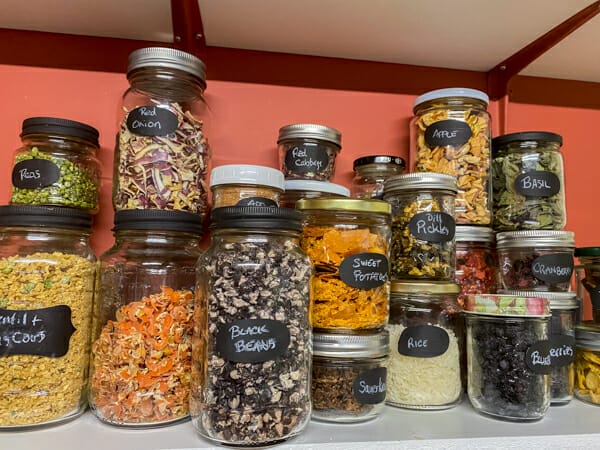
If you want to store a lot of food for more than a year, you’ll want to consider using oxygen absorbers, vacuum sealing and creating a temperature controlled environment.
If you’re like me and use your dried food within a year the following is all you need.
1.Cool Well Before Storing
When food is finished, let it cool completely before storing in jars or bags. Warm food in a glass container will cause condensation and that condensation can easily be absorbed by the food. If there is too much reabsorption, the food will be susceptible to mold and other pathogens.
A good rule of thumb is to let food rest and cool overnight before storing.
2.Condition Food Before Storing
When food comes out of the dehydrator, some pieces will have a little more moisture in them than others. Some of that moisture will be absorbed by drier pieces in the jar. It can take up to ten days for dried food in a jar to equalize and become equally dry. This is especially true for fruit since it is dried with a slightly higher moisture content than vegetables or other food.
Therefore, check your dried food at the 10 day mark to be sure it’s dry throughout. If you notice any signs of moisture, return to dehydrator, store food in freezer or eat right away.
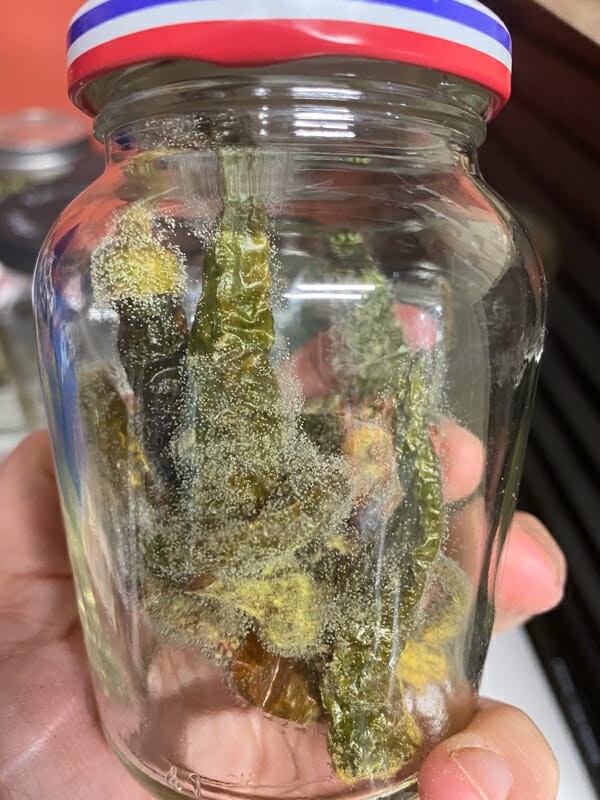
3.Store Food in Large Pieces
The more you break and crumble food the more surface area will be exposed to air and light. Herbs in particular will keep their flavour longer if you keep them whole rather than crumbling. They’ll take more space, but they’ll taste better.
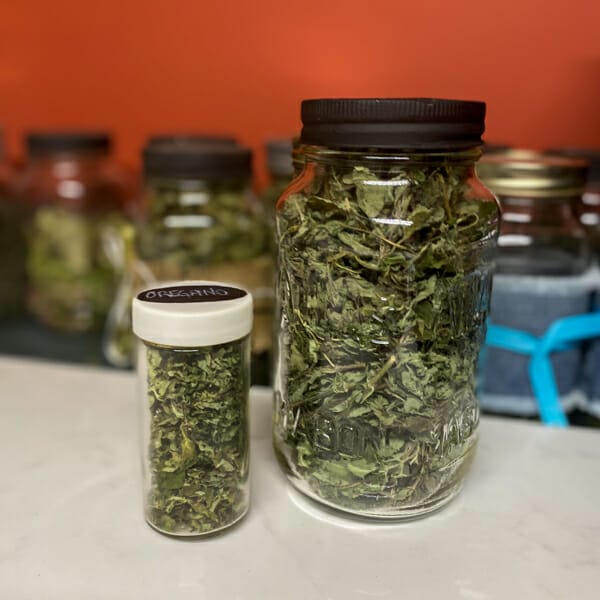
4.Use Tightly Sealed Containers
Use containers that will keep out oxygen and insects. Glass jars, plastic containers or freezer bags that seal well will work. If you have opaque or dark coloured containers to keep out light even better! Any glass jar with a tight fitting lid will do, you do not need to use canning jars.
Vacuum sealing will extend shelf life even further but is not necessary for food that will be used within six months to a year.
5.Match the Size of Containers to the Food
Use containers that match the size of the food so there’s little airspace left in the container. Remember, less exposure to oxygen or air is ideal.
If using plastic bags, squeeze out as much air as possible. You can even insert a straw in a small opening before sealing to suck out the air as a DIY vacuum seal.
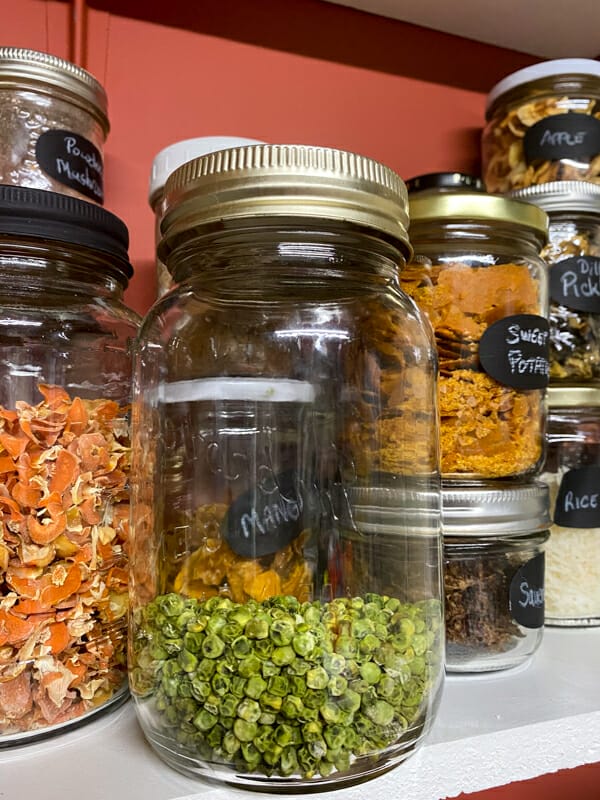
6.Reseal Containers Well
When using or removing food for use, be sure to reseal containers well, removing as much air as possible. If need be, move food to a smaller sized container to reduce exposure to air.
7.Store in a Dry, Dark Place with Consistent Temperature
The ideal storage place is dry, dark and cool (10°C/50°F). If a cool place is difficult to find, the next best place is the coolest place you can find where the temperature stays the same all year long. For example, a dark cupboard at room temperature is better than a non-insulated garage where temperatures vary greatly.
8. Keep food off the Ground
All restaurants and food businesses know this is one of the key rules for food storage and one of the first things food inspectors look for. The potential for contamination from leaks and spills is too great. Place a pallet or couple of two by fours on the floor to keep things elevated.
9.Store in Freezer if in Doubt
If you have any doubts about the fat content or dryness of your food, store it in the freezer for maximum shelf life.
10.Remember First In, First Out
Just like in your fridge and cupboards, a good rule of thumb is to use the oldest food first. When storing food, move the oldest food to the front and store the newest in the back.
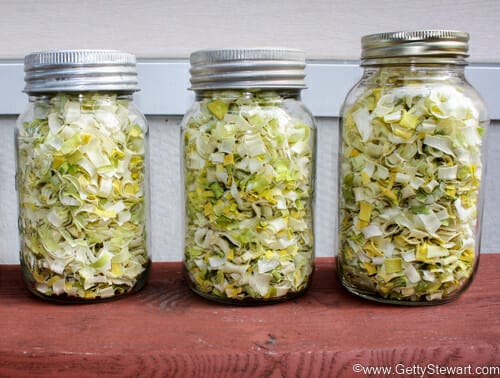
How Long Can You Store Dehydrated Food?
In theory, if food is dried effectively, stored at the optimum temperature in containers where air and light cannot penetrate and humidity levels are constant, it should last ten, twenty or even thirty years. The food will remain safe, but colour and flavour will be compromised.
For most of us, meeting the optimum conditions in our modern, warm homes can be challenging. The length of time we’re able to store dried food directly relates to how carefully we follow all of the recommendations for storing food. The more casual you are about this, the shorter the shelf life. And hey, if that works for you, no problem. For example, in my house I don’t need to even think about how I’m going to store dried apple rings or fruit leather – it gets eaten before I even have a chance to pull out an empty container.
With that in mind, here are some suggested time frames if you live in a typical home where you’re storing food in a sealed container on a shelf in a dark cupboard or room where temperatures are kept comfortable throughout the seasons (ie. room temp). These time frames will help you enjoy the best quality from your dried foods.
If you make occasional snacks – use your foods within 3 months.
If you dry your garden produce – use it before next year’s crop, or 12 months.
If you prepare meals for backcountry travelling – use your meals within 3 months or store in the freezer.
If you’re someone who wants to prep major amounts of food for survival, consider building a storage area where you have more control over temperature, air, pests and moisture.
Fundamentals of Dehydrating Trail Food – Handouts & Video

Do you have any questions about storing dried food? What tips or ideas can you add to the list? I love getting reader’s questions and the opportunity to learn more. Leave a comment below or tag me on Instagram @getgettys and Facebook @GettyStewart.HomeEconomist.


My plums aren’t dry enough even after 15 hours in the dehydrator, I’m going to put them in the freezer, when I take them out do I have to use them right away?
Thank you
Betty
Any food that is not thoroughly dry and stored in the freezer, needs to be treated like frozen food, not dehydrated food. Since your plums are not completely dry, when you take them out of the freezer use them within 3-4 days and keep in fridge.